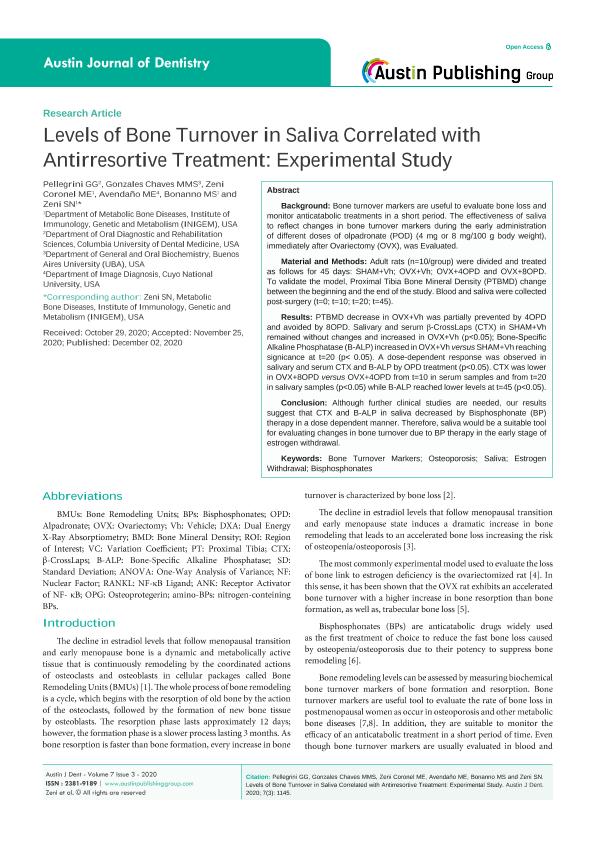Artículo
Levels of Bone Turnover in Saliva Correlated with Antirresortive Treatment: Experimental Study
Pellegrini, Gretel Gisela ; González Chaves, Macarena; Zeni Coronel, Estefania Magali
; González Chaves, Macarena; Zeni Coronel, Estefania Magali ; Avendaño, María Eugenia; Bonanno, Marina Soledad
; Avendaño, María Eugenia; Bonanno, Marina Soledad ; Zeni, Susana Noemi
; Zeni, Susana Noemi
 ; González Chaves, Macarena; Zeni Coronel, Estefania Magali
; González Chaves, Macarena; Zeni Coronel, Estefania Magali ; Avendaño, María Eugenia; Bonanno, Marina Soledad
; Avendaño, María Eugenia; Bonanno, Marina Soledad ; Zeni, Susana Noemi
; Zeni, Susana Noemi
Fecha de publicación:
12/2020
Editorial:
Austin Publishing Group
Revista:
Austin Journal of Dentistry
e-ISSN:
2381-9189
Idioma:
Inglés
Tipo de recurso:
Artículo publicado
Clasificación temática:
Resumen
Background: Bone turnover markers are useful to evaluate bone loss and monitor anticatabolic treatments in a short period. The effectiveness of saliva to reflect changes in bone turnover markers during the early administration of different doses of olpadronate (POD) (4 mg or 8 mg/100 g body weight), immediately after Ovariectomy (OVX), was evaluated.Material and Methods: Adult rats (n=10/group) were divided and treated as follows for 45 days: SHAM+Vh; OVX+Vh; OVX+4OPD and OVX+8OPD. To validate the model, Proximal Tibia Bone Mineral Density (PTBMD) change between the beginning and the end of the study. Blood and saliva were collected post-surgery (t=0; t=10; t=20; t=45).Results: PTBMD decrease in OVX+Vh was partially prevented by 4OPD and avoided by 8OPD. Salivary and serum β-CrossLaps (CTX) in SHAM+Vh remained without changes and increased in OVX+Vh (p<0.05); Bone-Specific Alkaline Phosphatase (B-ALP) increased in OVX+Vh versus SHAM+Vh reaching signicance at t=20 (p< 0.05). A dose-dependent response was observed insalivary and serum CTX and B-ALP by OPD treatment (p<0.05). CTX was lower in OVX+8OPD versus OVX+4OPD from t=10 in serum samples and from t=20 in salivary samples (p<0.05) while B-ALP reached lower levels at t=45 (p<0.05).Conclusion: Although further clinical studies are needed, our results suggest that CTX and B-ALP in saliva decreased by Bisphosphonate (BP) therapy in a dose dependent manner. Therefore, saliva would be a suitable tool for evaluating changes in bone turnover due to BP therapy in the early stage of estrogen withdrawal.
Palabras clave:
BONE TURNOVER MARKERS
,
OSTEOPOROSIS
,
SALIVA
,
ESTROGEN WITHDRAWAL
,
BISPHOSPHONATE
Archivos asociados
Licencia
Identificadores
Colecciones
Articulos(INIGEM)
Articulos de INSTITUTO DE INMUNOLOGIA, GENETICA Y METABOLISMO
Articulos de INSTITUTO DE INMUNOLOGIA, GENETICA Y METABOLISMO
Citación
Pellegrini, Gretel Gisela; González Chaves, Macarena; Zeni Coronel, Estefania Magali; Avendaño, María Eugenia; Bonanno, Marina Soledad; et al.; Levels of Bone Turnover in Saliva Correlated with Antirresortive Treatment: Experimental Study; Austin Publishing Group; Austin Journal of Dentistry; 7; 12-2020; 1-5
Compartir



